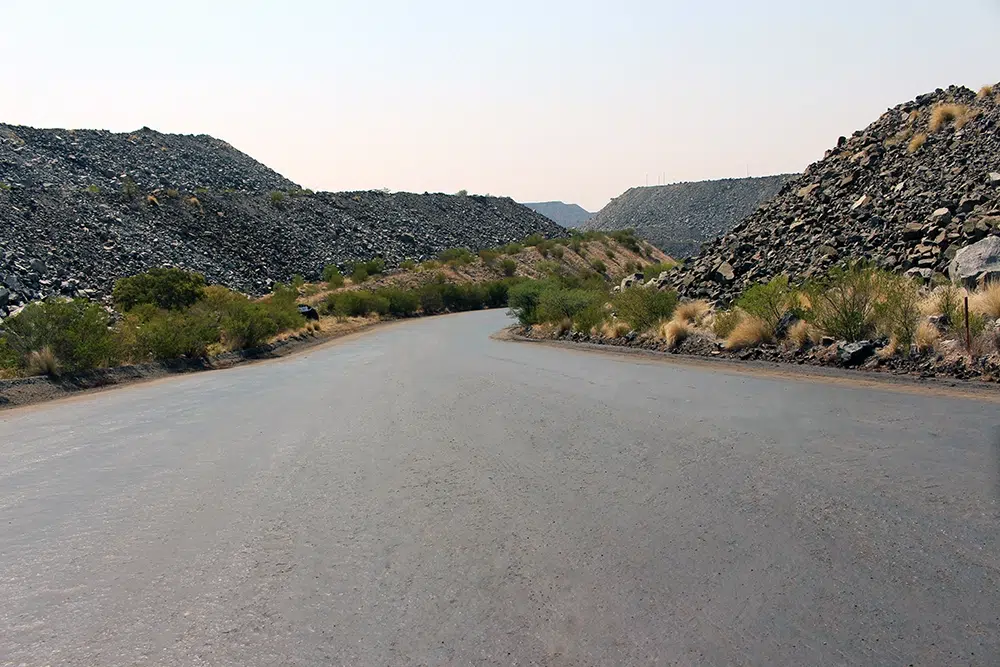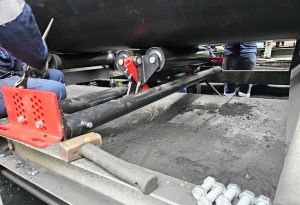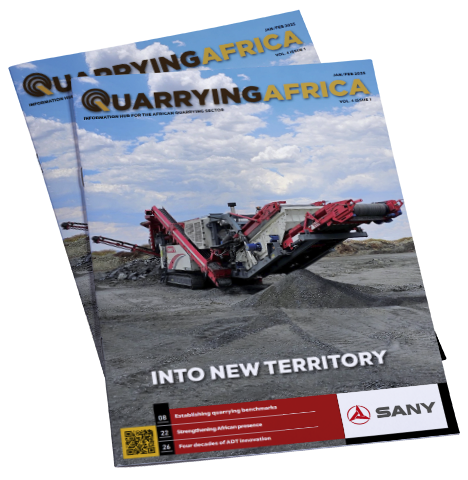Amid evolving customer needs and new market trends, Fillipus Masipa, Group Chief Technical Officer at Dust-A-Side, explains how the company places research and development (R&D) at the forefront of its operations to add value to its clients through innovation in haul road dust control for mines and quarries.
In mines and quarries, dust is a relentless challenge – from blasting and haul roads to tipping points and processing plants. Haul road dust, in particular, is a major headache for the mine operations, operators and the environment. As Masipa highlights, the – excessive dust not only undermines productivity but also poses serious risks to both people and the environment.
Wheel-generated dust from haul roads in mines and quarries is a major culprit behind fugitive and airborne dust, responsible for roughly 40% of total emissions. To tackle this, control measures must be both straightforward and highly effective. Airborne dust not only clouds visibility for dump truck operators, impairing their ability to spot hazards and prevent collisions, but also leads to costly damage from stray ore impacting truck tyres.
Dust particles, known as PM10, float ominously in the air, carrying both inhalable and respirable threats that can seriously jeopardise workers’ health. Beyond the serious health risks, these airborne particles reduce visibility, creating hazardous working conditions and undermining productivity.
“Dust fallout can irritate the upper respiratory tract – affecting the throat, nose and eyes – making working conditions highly uncomfortable. Depending on mineral composition, PM10 dust can also lead to severe occupational diseases such as pneumoconiosis,” explains Masipa. “Effective dust suppression in mines and quarries is therefore crucial to ensure worker safety, environmental protection, and productivity improvement.”
The impact of implementing an effective dust control system in mines and quarries is profound. Prioritising worker health and safety through superior dust suppression creates a positive ripple effect throughout the entire value chain. Enhanced visibility from reduced dust levels boosts productivity, while a well-maintained, sealed hauling surface cuts rolling resistance, leading to significant savings on fuel and tyres. The benefits are clear: improved working conditions drive efficiency and cost savings, amplifying the overall value of mining operations.
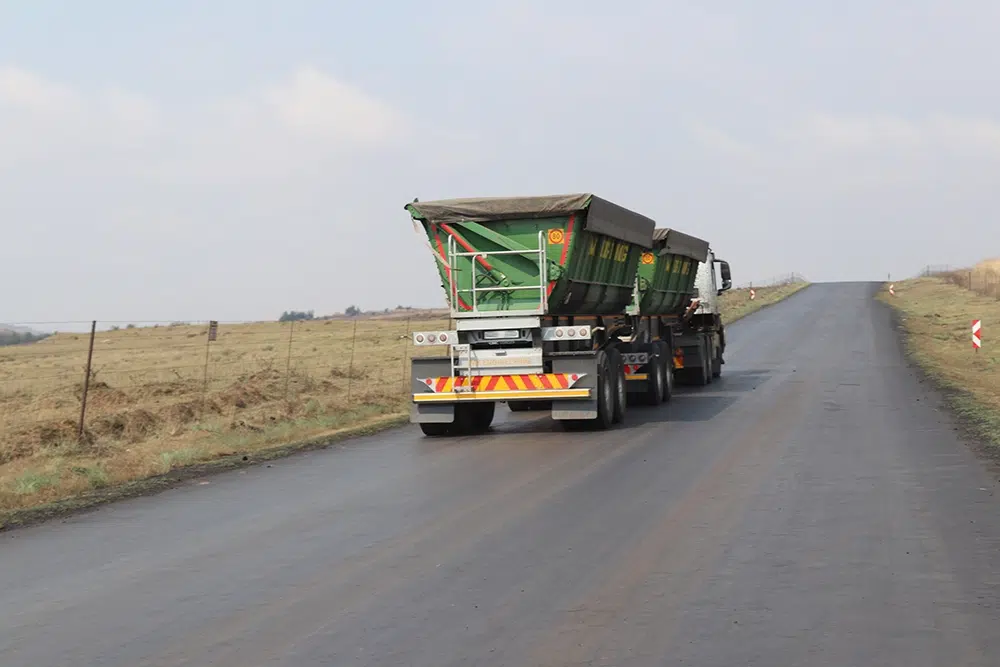
Green economies
Aligned with the ESG drive in mining, sustainability is now a central force shaping the dust control market. Mines and quarries are increasingly prioritising eco-friendly solutions that reduce water and energy consumption, along with minimising chemical usage. This commitment to greener practices not only enhances operational efficiency, but also supports the industry’s broader environmental goals.
“The growing adoption of eco-friendly raw materials in the production of dust control products is driving both current and future trends in the dust palliatives market,” explains Masipa. “Dust-A-Side has teamed up with reputable suppliers of green raw materials to enhance its dust control solutions. The rise of eco-friendly and cost-effective dust palliatives is gaining traction, offering significant benefits, especially for small and junior miners.”
With a robust R&D regime in place, Dust-A-Side is perfectly positioned to capitalise on this trend. The company’s R&D team, composed of highly qualified graduates from esteemed institutions in South Africa, is well-equipped to drive innovation in dust control solutions. Their commitment to meticulous selection, testing and approval of raw materials has solidified Dust-A-Side’s reputation as a leading supplier in the field.
“R&D is all about turning innovation into action. Feedback from customer interactions – through weekly engagements, monthly service level agreements, satisfaction surveys and business reviews – plays a crucial role in guiding our product and service development. Moreover, shifts in environmental laws and the evolving locations of mines and quarries in our export markets drive the creation of newer, greener, and more innovative solutions. These strategies reinforce our position as the industry’s preferred choice,” says Masipa.
Dust-A-Side haul road solutions include a range of dust palliatives, from non-binders and binder-based options to surfactant-based and conventional binders such as lignosulphonate. The company’s offering also features emulsified bituminous emulsions, synthetic polymers and specialised binders.
The company’s commitment to consistent product quality and client service is further demonstrated by Dust-A-Side’s ISO 9001 and 14001 certifications, which have been successfully maintained for over a decade.

Award winning product range
With over 40 years of experience and a pioneering role in haul road dust control for both underground and surface haul roads, Dust-A-Side has over time refined and expanded its extensive range of products.
Dust-A-Side’s haul road solutions include a range of dust palliatives, from non-binders and binder-based options to surfactant-based and conventional binders such as lignosulphonate. The company’s offering also features emulsified bituminous emulsions, synthetic polymers and specialised binders.
DAS Bio, an eco-friendly dust control product with less bitumen binders, remains one of the most cost-effective and sustainable binders available – even more relevant due to the growing demand for greener and more versatile dust palliatives. This product earned Dust-A-Side the Local Manufacturing Innovation award at the 2022 Electra Mining exhibition.
The emulsified ligno-bitumen binder is a carefully engineered solution that has consistently demonstrated its effectiveness across various soil types, including clayey, sandy, gravelly and Pedocretes.
For permanent roads which are being newly established, DAS Bio can be incorporated into the wearing course layer of the road. This happens via a scarifying, spraying, mixing and rolling process. This provides excellent dust control and sealing properties for the road.
In order to suppress dust on more temporary road surfaces, DAS Bio can instead be applied via a series of light dilution spraying, using a water cart. Once applied, the need for reapplication is minimal. Mines which typically rely on continuously spraying untreated water on haul road networks in order to control dust will dramatically reduce water usage and water cart hours by switching to DAS Bio.
DAS Bio is conveniently delivered in a concentrated liquid form ready to use. It is typically diluted in a water cart at a concentration of 2,5% right up to 50% depending on the specific requirement.
“Our potential and current customers can look forward to exciting and innovative dust palliatives soon to be launched, which will further enhance our range of solutions,” says Masipa.
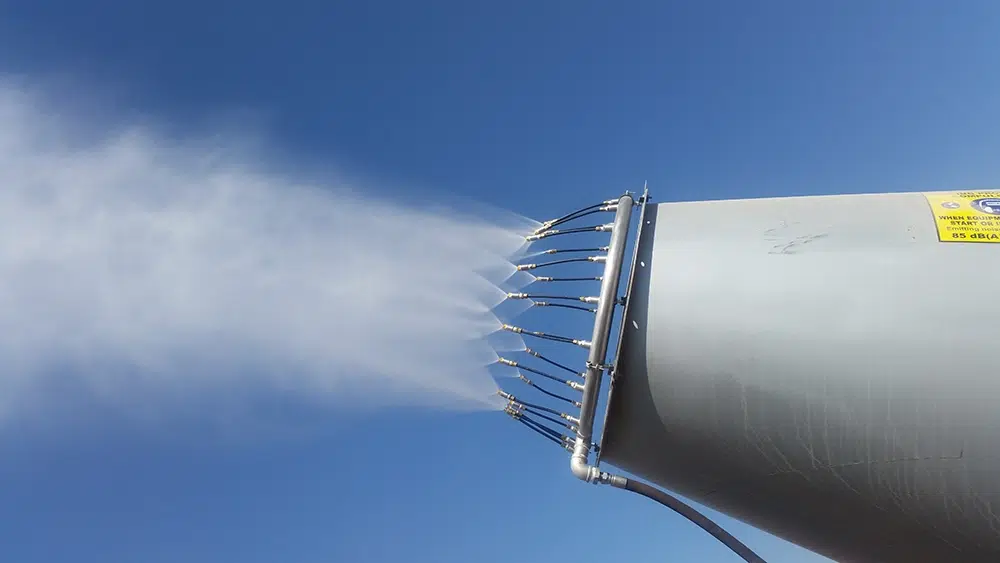
Fog cannons
In addition to surface and underground road network dust control, Dust-A-Side offers a range of high-pressure mist systems, fog cannons and dust monitoring systems. Fog cannons have been on offer at Dust-A-Side since 2018, with a handful of clients currently averaging a minimum of two fog cannons on site.
Drilling and blasting sites, for example, generate excessive airborne dust. In a Dust-A-Side fog cannon configuration, water passes through a series of misting nozzles at an above-industry standard of 40 bar, creating a dense mist cloud, dispersed across large areas by an industrial-sized fan. Fog cannons are thus, mainly used to create a mist curtain barrier to prevent clouds of billowing dust from traveling on air currents to nearby communities.
Dust settling over communities decreases visibility, poses lung-related health risks, and is a general unsightliness and nuisance to the residents. The atomized water droplets agglomerate with the dust particles to increase their mass, preventing dust from floating on the air currents and therefore, mitigating the health and safety hazards to nearby communities.
Fog cannons are ideally suited for suppressing dust in areas where wind plays a major role. The technology allows for better coverage with water, specifically when treating open tip areas where there are no structures in place, and where there are fewer options available to install static nozzle manifold arrangements. Quarries and tailings operations can make use of fog cannons to disperse the mist over large areas, to suppress dust, evaporate excess water and prevent airborne dust from traveling during blasting and drilling activities.
In tipping and crushing applications, fog cannons can be installed to operate automatically using radar sensors. For example, once a vehicle, such as a haul truck, moves into position, ready to tip, the radar sensor detects the moving vehicle, and initiates the fan and high-pressure mist system, which are connected and mounted onto the trajectory outlet side of the fog cannon. The system will automatically switch off after a predetermined time, as set from the control panel, once the vehicle has completed the tip and moved away.
A case study example of a client using Dust-A-Side fog cannons is a surface mining operation in South Africa, which uses a combination of 21 fog cannons along its boundary wall. These fog cannons are remotely controlled to oscillate to accommodate wind direction and ensure maximum protection of the nearby community from mining dust emissions.
